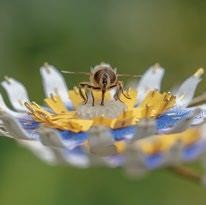As cities rise and their habitats shrink, designers are finding ways to prevent the decline of city-dwelling pollinators.


The fact that declining bee populations pose a serious threat to global food security is not a revelation, but we’ve been looking too narrowly at one bee. Of 20,000 species worldwide, solitary bees form the overwhelming majority, with only a fraction being honey bees that have hogged the limelight.
The decline of solitary bees is worrying as they can be more effective pollinators than honey bees. Without “pollen baskets” on their hind legs, they distribute pollen far better. The red mason bee, for instance, is equivalent to 120 worker honeybees in the pollination it provides.
In Europe, one-third of wild bee species, including solitary bees, have declined, reports the UN Food and Agriculture Organization. And designers have taken notice, creating innovative structures to feed and shelter our tiny neighbours. For those who fear bees, know this: Solitary bees are non-aggressive as they do not swarm or produce honey (so there’s no need to guard it), and most don’t sting as all females are fertile – unlike in hives where worker bees may attack to protect their queen.
Seems like solitary bees may actually be the most temperamentally suited to live with us.
01 MEXICO
Mexico-based creative agency Maliarts has designed structures named Refugio to provide food, water and shelter for solitary bees. The shelter (made of unfinished wood coated with natural oil) acts as both a resting and nesting place; the feeder (right) contains food for areas without enough flowers; and the waterer (left) provides hydration. Maliarts two-year efforts were inspired by an article that discussed how pollinating insects have found refuge in gardens, supporting the idea that cities can play a role in the conservation of biodiversity. Happily, the shelters placed in Tlatelolco Orchard in Mexico City – as well as in Malinalco, Queretaro, Puebla and Guadalajara – have welcomed the striped occupants, who have also begun nesting.

02 LONDON
French designer Marlene Huissoud teamed up with King’s College London scientists to dedicate her first “chair” to insects. The aim of her project, Please Stand By, is to get humans to “stand by” and come to terms with the impact of humanity on nature. Not for humans, the structures are made of unfired clay, natural binders and wood, with 5cm- to 10cm-deep holes to host the insects in a safe haven. The chairs were exhibited at Thurloe Square Garden in South Kensington during last year’s London Design Festival. Discussions to locate them permanently in museums and institutions are ongoing.

03 THE NETHERLANDS
Dutch designer Matilde Boelhouwer has designed artificial flowers for city-dwelling bees who may otherwise starve. The Food for Buzz project comprises five blooms to draw the “big five” of pollination – bees, bumblebees, hoverflies, butterflies and moths. Screen-printed polyester petals feature a vessel at the centre to collect rain, which is linked to a hollow stem containing sugar. The mixed solution is then automatically pumped back up. So far, a trial has been conducted in the city of Eindhoven.
TEXT ADELINE WONG PHOTOS SERGIO LOPEZ, BERNARDO FIGUEROA AND JANNEKE VAN DER POL























